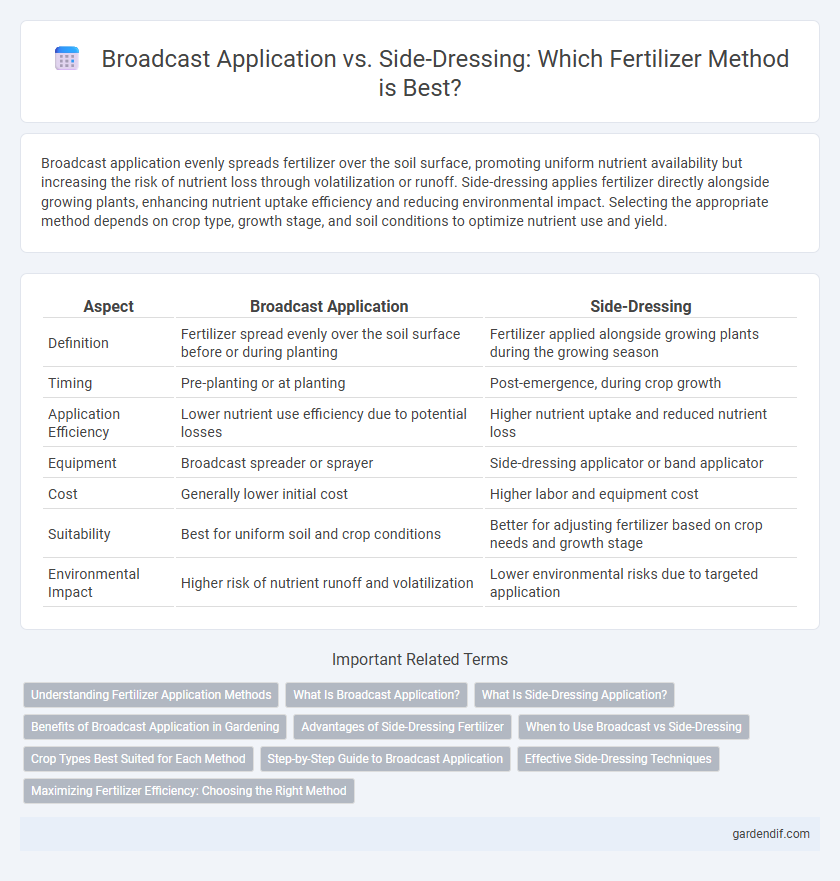
Broadcast application vs Side-dressing Illustration
Broadcast application evenly spreads fertilizer over the soil surface, promoting uniform nutrient availability but increasing the risk of nutrient loss through volatilization or runoff. Side-dressing applies fertilizer directly alongside growing plants, enhancing nutrient uptake efficiency and reducing environmental impact. Selecting the appropriate method depends on crop type, growth stage, and soil conditions to optimize nutrient use and yield.
Table of Comparison
| Aspect | Broadcast Application | Side-Dressing |
|---|---|---|
| Definition | Fertilizer spread evenly over the soil surface before or during planting | Fertilizer applied alongside growing plants during the growing season |
| Timing | Pre-planting or at planting | Post-emergence, during crop growth |
| Application Efficiency | Lower nutrient use efficiency due to potential losses | Higher nutrient uptake and reduced nutrient loss |
| Equipment | Broadcast spreader or sprayer | Side-dressing applicator or band applicator |
| Cost | Generally lower initial cost | Higher labor and equipment cost |
| Suitability | Best for uniform soil and crop conditions | Better for adjusting fertilizer based on crop needs and growth stage |
| Environmental Impact | Higher risk of nutrient runoff and volatilization | Lower environmental risks due to targeted application |
Understanding Fertilizer Application Methods
Broadcast application involves evenly spreading fertilizer across the entire soil surface, ensuring widespread nutrient availability for crops, but it may lead to nutrient loss through volatilization and runoff. Side-dressing places fertilizer directly alongside growing plants, enhancing nutrient uptake efficiency and minimizing environmental impact by targeting root zones precisely. Selecting the appropriate method depends on crop type, growth stage, and soil conditions to optimize yield and fertilizer use efficiency.
What Is Broadcast Application?
Broadcast application involves evenly spreading fertilizer across the entire soil surface before or during planting, ensuring uniform nutrient availability for the crop. This method is suitable for large fields and various crop types, promoting widespread nutrient distribution but may result in nutrient loss due to runoff or volatilization. Broadcast fertilizer application is commonly used for nitrogen, phosphorus, and potassium compounds to support initial crop growth stages.
What Is Side-Dressing Application?
Side-dressing application involves placing fertilizer directly beside the crop row after plants have emerged, improving nutrient uptake efficiency and minimizing losses compared to broadcast application. This method targets the root zone more precisely, enhancing nitrogen availability during critical growth stages and reducing environmental runoff. Side-dressing is particularly effective for row crops like corn and vegetables, optimizing fertilizer use and boosting yield potential.
Benefits of Broadcast Application in Gardening
Broadcast application distributes fertilizer evenly across the entire garden area, promoting uniform nutrient availability for all plants. This method enhances soil fertility quickly and supports diverse plant growth without the need for intensive labor. Broadcasting also reduces the risk of root burn by preventing concentrated fertilizer spots, making it ideal for establishing healthy gardens.
Advantages of Side-Dressing Fertilizer
Side-dressing fertilizer delivers nutrients directly to the root zone, enhancing nutrient uptake efficiency and reducing fertilizer wastage compared to broadcast application. This targeted approach minimizes nutrient runoff and environmental impact while promoting better crop growth and higher yields. Side-dressing also allows for timely nutrient application during critical growth stages, optimizing plant health and productivity.
When to Use Broadcast vs Side-Dressing
Broadcast fertilizer application is ideal before planting or early in the growing season to ensure nutrients are evenly distributed across the soil surface for crops requiring uniform nutrient availability. Side-dressing is most effective during the growing season when plants need targeted nutrient boosts, especially nitrogen, to support rapid growth and increase yields. Choosing broadcast versus side-dressing depends on crop type, growth stage, and specific nutrient requirements for optimal fertilizer efficiency.
Crop Types Best Suited for Each Method
Broadcast application is ideal for cereal grains such as wheat and barley, where uniform nutrient distribution supports early growth stages. Side-dressing suits row crops like corn and soybeans, allowing targeted nutrient placement near the root zone during critical growth periods. Selecting the appropriate method enhances nutrient use efficiency and maximizes yield potential for specific crop types.
Step-by-Step Guide to Broadcast Application
Broadcast application involves evenly spreading fertilizer across the entire soil surface, enhancing nutrient availability for crops at early growth stages. Begin by calibrating the spreader to the recommended fertilizer rate, then walk at a steady pace to ensure uniform distribution, avoiding overlapping or missed spots. This method is efficient for large fields but requires incorporation through tillage or irrigation to minimize nutrient loss and maximize uptake.
Effective Side-Dressing Techniques
Effective side-dressing techniques involve placing fertilizer close to the plant roots, enhancing nutrient uptake efficiency and reducing environmental runoff compared to broadcast application. Precise timing during crop growth stages maximizes nitrogen availability when demand peaks, improving yield and minimizing waste. Using banding tools or injector systems ensures uniform distribution and optimal placement to support healthy plant development.
Maximizing Fertilizer Efficiency: Choosing the Right Method
Broadcast application evenly distributes fertilizer across the soil surface, promoting uniform nutrient availability for crops but may lead to higher losses through volatilization or runoff. Side-dressing targets fertilizer placement directly near the root zone, enhancing nutrient uptake efficiency and reducing waste. Choosing side-dressing over broadcast application can significantly maximize fertilizer efficiency by delivering nutrients precisely when and where plants need them most.
Broadcast application vs Side-dressing Infographic

 gardendif.com
gardendif.com